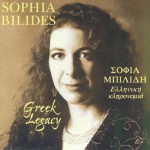Welcome to Kef Times’ first installment of Balkan Songs. Each time this column appears, we will bring you musical notation, translation and background for a specific song.
For this issue, we delve into the Balkan Tunes archive (specifically winter, 1994-95) [Ed. Note: Balkan Tunes was a newsletter Bill Cope published in the 1990s that featured, well, Balkan tunes.] and emerge with “Dhimitrúla,” a song made famous by the Smyrneika singer Roza Eskenazi.

D. Semsis, A. Tomboulis, R. Eskenazi (Athens, 1932) Photo: Wikipedia
Welcome to Kef Times’ first installment of Balkan Songs!
For this issue, we delve into the Balkan Tunes archive (specifically winter, 1994-95) [Ed. Note: Balkan Tunes was a newsletter Bill published in the 1990s that featured, well, Balkan tunes.] and emerge with “Dhimitrúla,” a song made famous by the Smyrneika singer Roza Eskenazi, pictured here.
In the 1990s, Miamon Miller and I, with help from Sophia Bilides, transcribed the tune and Sophia provided the translation.
“'Dhimitrúla’ is a song from the Smyrneika tradition (urban, early 1900s cabaret-style songs of the Greeks from Smyrna/Asia Minor),” writes Sophia. “It is attributed to the composer-musician Panayiotis Toundas and was recorded twice by Roza Eskenazi, first circa 1934, and again about 20 years later.”
Sophia recorded this song on her Greek Legacy CD; the the track and the full CD are available at cdbaby, Amazon.com and her website.
“I based my version on the 1934 recording,” Sophia writes, “in part because it featured the violí playing of the great Dimitrios Semsis, and because all the musicians at that session were in agreement on the rhythm, which is the old-style karsilamá (1-2 1-2-3 1-2 1-2). The later recording is a mess, rhythmically, with the musicians arguing instrumentally about whether to use the old-style karsilamá or the more common karsilamá rhythm which places the 1-2-3 at the end of each measure, which in the case of this particular song necessitated an extra beat as a fudge factor. (The ‘fudge mix’ has been carried over to contemporary versions of the song.)
 “In addition to having a great sing-along chorus, Dhimitrúla is special to me because it’s one of the few songs I know of that actually mentions the word kéfi, that ‘frame of mind, a good mood or spirit, considered essential before the music-making can begin’—to quote my own liner notes.”
“In addition to having a great sing-along chorus, Dhimitrúla is special to me because it’s one of the few songs I know of that actually mentions the word kéfi, that ‘frame of mind, a good mood or spirit, considered essential before the music-making can begin’—to quote my own liner notes.”
From Bill: Our 1990s transcription and Sophia’s translation appear in the attached PDF. The last page of the PDF is an added version I did back in 2007 that actually combines the version the Greeks like to hear these days and the original version.
By the way, if any reader would like the piece in a different key, I would be happy to provide that; and also, if you use Finale, I would be happy to give you the original files, to use as you please—just email me.
Click here to hear the 1930s Roza Eskenazi version of this tune on You Tube
Click here for the PDF: Dhimitrula - musical transcription, translation, background.
 Bill Cope is a multi-instrumentalist who began playing Balkan music in 1975 and teaching at the Balkan Music & Dance Workshops in 1982. He's made numerous trips to the Balkans and has studied and performed with many noted players and singers. Read a profile about him in the Spring 2007 Kef Times.
Bill Cope is a multi-instrumentalist who began playing Balkan music in 1975 and teaching at the Balkan Music & Dance Workshops in 1982. He's made numerous trips to the Balkans and has studied and performed with many noted players and singers. Read a profile about him in the Spring 2007 Kef Times.
Bill is editor of Kef Times’ Balkan Songs. If you have an idea and transcriptions, translation and background for an interesting song to be featured in a future issue, please contact him.


